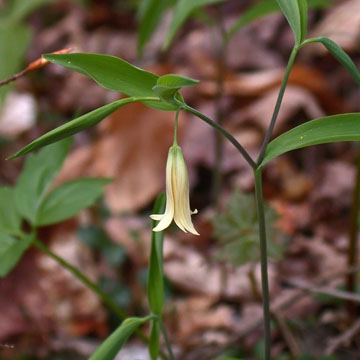

Uvularia sessilifolia - (image 1 of 6)
Taxonomy
Family: Liliaceae
Habitat
Woods.
Associates
Distribution
Nova Scotia and New Brunswick to MN and SD, south in mountains to SC, western FL and LA.
Morphology
Perennial from a slender rhizome; stem 10-30 cm at anthesis, bearing 0-2 leaves below the fork and only 1 or 2 flowers; leaves at anthesis lance-oblong, acute at both ends, glaucous beneath, at maturity elliptic, up to 8 cm long, obtuse or rounded at the base, nearly smooth on the margins; tepals pale stramineous, 12-25 mm; styles connate for 3/4 of their length, about equaling the perianth, much exceeding the anthers; fruit 3-angled, distinctly stipitate.
Notes
Flowers April to May
Wetland indicator: FACU
This species could be mistaken for Polygonatum pubescens if plants are without flowers or fruit, though the stem is usually forked unlike Polygonatum. Both have leaves that are pale on the underside but in P. pubescens the surface is glaucous and the smaller veins have numerous minute hairs while in U. sessilifolia the surface is glaucous only, not hairy.
A similar more southern species, U. puberula Michx, differs mainly in the styles which are only connate well below the middle, leaves that are rigid, shiny, and minutely serrate, and stem that is hairy in lines below the leaf bases. It occurs in mountain woods in MD, southwest PA, VA, WV, and GA and a form with a smooth stem and thinner leaves (var. nitida) occurs on the coastal plain from Long Island to SC.
References
Gleason, Henry A. and A. Cronquist. 1991. Manual of Vascular Plants of Northeastern United States and Adjacent Canada. Second Ed.
The New York Botanical Garden. Bronx, NY
|
Michael Hough © 2018 |